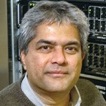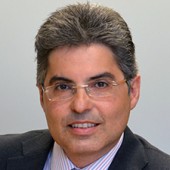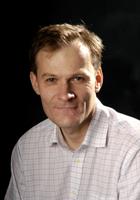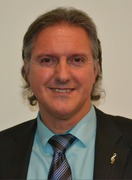Keynote/Plenary Speakers

Professor Arokia Nathan, University of Cambridge, UK
Amorphous oxide semiconductors (AOS) are a key material for future electronics because of their high mobility, excellent film quality even when layered at room temperature, and low fabrication cost. The AOS provides transparency because of its wide band-gap, allowing the development of transparent systems. This talk will review the mechanisms underlying dark and light instability in oxide thin-film transistors.
Although this family of materials is optically transparent, the presence of oxygen deficiency defects, such as vacancies and interstitials, located at sub-gap states, and their ionization under illumination, leads to absorption of blue and green photons. At higher energies, we have the usual band-to-band absorption. In particular, the oxygen defects remain ionized even after illumination ceases, eluding to persistent photoconductivity, which can limit the frame-rate of active matrix imaging arrays. However, the persistence in photoconductivity can be overcome with a positive gate pulsing scheme to enable a realistic frame rate for sensor-embedded display for touch-free interaction.
Professor Arokia Nathan holds the Chair of Photonic Systems and Displays in the Department of Engineering, Cambridge University. He received his PhD in Electrical Engineering from the University of Alberta. Following post-doctoral years at LSI Logic Corp., USA and ETH Zurich, Switzerland, he joined the University of Waterloo. In 2006, he moved to the UK to take up the Sumitomo Chair of Nanotechnology at the London Centre for Nanotechnology, University College London. He has published over 500 papers in the field of sensor technology and CAD, and thin film transistor electronics, and is a co-author of four books with over 50 patents filed/awarded. He is a Chartered Engineer (UK), Fellow of the Institution of Engineering and Technology (UK), Fellow of IEEE (USA), and an IEEE/EDS Distinguished Lecturer.

Dr Luigi Occhipinti, EPSRC Centre for Large Area Electronics, University of Cambridge, UK
The adoption of physical and chemical sensors in high growth markets, from consumer electronics to automotive and healthcare drove the exponential growth in volume from about 20 million in 2007 to more than 3.5 billion in 2012, driven by some key technologies such as MEMS-based accelerometers and gyroscopes.
Based on the trend analysis and forecasts of market research organizations, sensor demand is expected to grow from billions in 2012 to trillions within the next decade, driven by the emergence of sensor- based smart systems fusing computing, communication and sensing, which will enable new markets in retail, Fast Moving Consumer Goods (FMCG), Point-Of-Care (POC) diagnostics and disposable electronics.
When compared to earlier sensor technologies, which were characterized by long development cycles, requiring more than a decade for converting proof of concepts to volume production, the advent of innovative manufacturing and hybrid integration technologies allows a dramatic reduction in the time to market.
Sensor technology alone is not enough to enable smart systems embedded in everyday objects, as in the visions and expectations of the “Internet of Things” (IoT) and “Wearable electronics”. New and revolutionary concepts of ultra-thin and conformable electronics, sensors and photonics, enabled by Large-Area Electronics manufacturing capabilities, are uniquely positioned to accelerate and lead the penetration of smart sensors and systems into new markets.
In emerging sensor and sensor network technologies, the sensing element needs to provide sufficient Signal to Noise Ratio (SNR) when the concentration of a specific substance reaches the minimum detection limit, and information highly specific to the particular target to detect. Combining simple electronics to amplify the signal at the point of detection is critical for achieving sufficient levels of SNR. Designing and manufacturing these application-specific electronic building blocks by means of simplified and cost-effective manufacturing process flows, such as those enabled by printed electronics, aims to reduce the time to market and increase the customization possibilities. This will ultimately enable “on-demand” design and development of a smart sensor unit into a truly flexible and conformable form factor.
Examples of programs and state-of-the-art developments in the field of smart sensors and systems will be described in the talk, highlighting the opportunity offered by Large-Area Electronics manufacturing and the challenges and limitations of conventional System-on-Chip (SoC) and System-in-Package (SiP) integration approaches, faced by today MEMS devices.
Dr Luigi Occhipinti joined the EPSRC Centre for Large Area Electronics, University of Cambridge, UK in April 2014 with more than 18 years of experience driving research and innovation in the global semiconductor industry, particularly in the field of post-silicon technologies. Luigi has an Electronic Engineering degree from the University of Catania and a PhD in Electrical Engineering from Rome University "Tor Vergata". He has authored and co-authored over 80 scientific publications and 35 patents.
Between 2009 and 2014, he worked as R&D Senior Group Manager and Programs Director at STMicroelectronics, leading company initiatives for new business development based on Heterogeneous Integration, Flexible and Disposable Electronics, MEMS-based sensors and diagnostic bio-systems. For more than a decade, Luigi has been an active and recognised expert in the field of OLAE (Organic and Large-Area Electronics) and innovative manufacturing techniques, acting as Project Coordinator and Principal Investigator of more than 12 EC funded programs, under Framework Programme 6 and FP7, in the areas of ICT (Information and Communication Technologies) and NMP (Nanosciences, Nanotechnologies, Materials, and new Production Technologies).

Prof. David Cumming - University of Glasgow
CMOS is at the heart of modern computing and communications technology. However, it is possible to think of the technology for making CMOS microelectronics as a material system with far more diverse possibilities. In this talk I will present results on the hybridisation of CMOS and nanotechnology for a range of sensor applications. These will include ion sensing for chemical and biological imaging and the all electronic next generation sequencing system. I will then explore the possibilities for hyperspectral and terahertz imaging based on the integration plasmonics and metatmaterial structures on CMOS.
Prof. David Cumming (B.Eng. Glasgow, Ph.D. Cambridge) is the Professor of Electronic Systems at Glasgow University where he is the Head of Electronics and Nanoscale Engineering in the School of Engineering. He runs the Microsystem Technology (MST) group with 20 researchers. His research into lab-in-a-pill led to the university spin-out, Mode Diagnostics. He worked for Ion Torrent Inc. that successfully commercialised his CMOS sensor technology for use in the personal genome machine. He is presently the Director of the Electronics Design Centre and the EPSRC KTA at Glasgow University.
In the past 10 years the MST Group has established a world-wide reputation for delivering integrated sensor systems and technologies for biomedical and imaging markets. The research has been funded by EU, EPSRC, SFC and UK industry. He is an FIET and SMIEEE and holds a Royal Society Wolfson Merit Award.

Dr.Sani Nassif, Radyalis LLC, Austin, USA
Microelectronics has changed the world in incredible and wonderful ways. Smart devices are now taken for granted and permeate every aspect of our daily lives. But atoms are finite, and the glorious run we’ve had down Moore’s slope is ending. What is a new (or old) researcher in this area to do? This talk will explore this topic, framed in a world of increasingly sophisticated systems that largely hide the underlying implementation technology.
Sani received his Bachelors degree with Honors from the American University of Beirut in 1980, and his Masters and PhD degrees from Carnegie-Mellon University in 1981 and 1985 respectively. He then worked for ten years at Bell Laboratories in the general area of technology CAD, focusing on various aspects of design/technology coupling including device modeling, parameter extraction, worst case analysis, design optimization and circuit simulation. While at Bell Labs, working under Larry Nagel -the original author of Spice, he led a large team in the development of an in-house circuit simulator, named Celerity, which became the main circuit simulation tool at Bell Labs.
In January 1996, he joined the then newly formed IBM Austin Research Laboratory (ARL), which was founded with a specific focus on research for the support of computer systems. Sani currently manages the Silicon Analytics department at ARL , which is focused on applying analytics to the design/technology coupling area and includes activities in: model to hardware matching, simulation and modeling, statistical modeling, statistical technology characterization and similar areas. In January 2014 Sani founded Radyalis, a company focused on applying VLSI-EDA techniques to the field of Cancer Proton Radiation Therapy.
Sani has authored numerous conference and journal publications, and delivered many tutorials at top conferences. He has received four Best Paper awards, authored invited papers to ISSCC, IEDM, ISLPED, HOTCHIPS, and CICC, given invited talks at Texas A&M University, RICE University, UCSB, UC Berkeley and Kyoto University. He has given Keynote and Plenary presentations at Sasimi, ESSCIRC/DERC, BMAS, SISPAD, SEMICON, PATMOS and ICCV. He is an IEEE Fellow, a member of the ACM and AAAS, and has a total of 44 patents. Sani is a member of the IBM Academy of Technology.
Dr. Nassif is currently serving as the Vice-President for Conferences of the IEEE council on EDA, and was the General chair of the ICCAD conference in 2008. He has previously also served on the technical program committees of DAC, ICCAD, DATE and ISQED, and on the executive committee of ISPD. He has received the Penrose award (given to one outstanding graduate from the American University of Beirut), the Distinguished Member of Technical Staff award from Bell Labs, two Research Accomplishment Awards from IBM, and the Mahboob-Khan Outstanding Mentor awards from the SRC.

Prof. Sandro Carrara, EPFL, Switzerland
Integrated electrochemical Nano-Bio-Sensors [1] for diagnosis and/or treatment of patients with specific physiological conditions (e.g., heart, cardiovascular, cancer diseases) or convalescents is a key factor to provide better, more rationale, effective and ultimately low-cost health care also at home. The ultimate goal of improved health care on those subjects is the extension of the patients’ autonomy, the possibility for auto-monitoring, the improvement of their comfort levels and their integration into everyday life. Some systems for on-line monitoring are available in the market. They use wearable devices (accelerometers, heartbeat monitoring system, etc). However, all these systems do not measure the human metabolism at molecular level (metabolites). The only available real-time, implantable/wearable systems for metabolic control are limited to glucose monitoring and used only for diabetic patients. However, electrochemical sensors may address so many other molecules, which have crucial relevance in human metabolism in chronic patients. So far, there are no available integrated nano-bio-systems for multi-metabolites, real-time, remote monitoring of the human metabolism. Thus, the aim of this plenary talk is to present an innovative concept for multi-panel, highly integrated, fully implantable, remotely powered and real-time monitoring systems for human metabolism at molecular level. The considered metabolic molecules will be glucose, lactate, glutamate, ATP [2], and anticancer drugs as well as anti-inflammatory ones [3]. In case of drugs, the specificity of electrochemical sensors is improved at system level [4]. The proposed nanotechnology will be based on carbon nanotubes to improve the sensors performance [3, 5]. To pursue their detection, innovative VLSI solutions [6] are discussed including the system remote powering [7]. The new approach is obtained by integrating nano/bio/micro/CMOS/SW/RF systems in three devices: (i) a fully implantable sensors array for data acquisition; (ii) a on-skin intelligent-patch for remote powering and signal processing; (iii) a wearable station (a mobile phone) for data collection, elaboration and storage. The major presented breakthroughs are in the areas of: (i) nano-sensors; (ii) signal analysis; (iii) HW/Bio co-design; (iv) multi-panel metabolites detection; (v) fully implantable sensors; (vi) remote powering; (vi) minimally-invasive biomedical implants. System validation with in-vivo experiments on animal models is presented too [8] including packaging issues [9].
Bibliography
[1] Sandro Carrara (Ed), Nano-Bio-Sensing, Springer, New York, 2010, ISBN 978-1-4419-6168-6
[2] Sandro Carrara, Léandre Bolomey, Cristina Boero, Andrea Cavallini, Eric Meurville, Giovanni De Micheli, Fabio Grassi, Tanja Rezzonico, Single-Metabolite Bio-Nano-Sensors and System for Remote Monitoring in Animal Model, proceedings of the IEEE Sensors Conference 2011
[3] Sandro Carrara, Andrea Cavallini, Victor Erokhin, Giovanni De Micheli, Multi-panel drugs detection in human serum for personalized therapy, Biosensors and Bioelectronics, 26 (2011) 3914–3919
[4] Camilla Baj-Rossi, Giovanni De Micheli, Sandro Carrara, Electrochemical Detection of Anti-Breast-Cancer Agents in Human Serum by Cytochrome P450-Coated Carbon Nanotubes, Sensors 12 (2012) 6520-6537
[5] Cristina Boero, Maria Antonietta Casulli, Jacopo Olivo, Eric Orso, Marco Mazza, Sandro Carrara, Giovanni De Micheli, Design, development and validation of an in-situ biosensor array for metabolite monitoring of cell cultures, Biosensors and Bioelectronics, 61 (2014) 251–259
[6] Sara S. Ghoreishizadeh, Camilla Baj-Rossi, Andrea Cavallini, Sandro Carrara, and Giovanni De Micheli, An Integrated Control and Readout Circuit for Implantable Multi-Target Electrochemical Biosensing, IEEE Transaction on Biomedical Circuit and Systems, TBCAS 8(2014) 891-898
[7] Jacopo Olivo, Sandro Carrara, and Giovanni De Micheli, A study of Multi-Layer Spiral Inductors for Remote Powering of Implantable Sensors, IEEE Transactions of Biomedical Circuits and Systems TBCAS 7(2013) 536-547
[8] Sandro Carrara, Camilla Baj-Rossi, Sara Seyedeh Ghoreishizadeh,Stefano Riario,
Grégoire Surrel, Francesca Stradolini, Cristina Boero, Giovanni De Micheli, Enver G. Kilinc, Catherine Dehollain, Full System for Translational Studies of Personalized Medicine with Free-Moving Mice, invited paper accepted for presentation at ISCAS 2015
[9] Camilla Baj-Rossi, Enver G. Kilinc, Sara S. Ghoreishizadeh, Daniele Casarino, Tanja Rezzonico Jost, Catherine Dehollain, Fabio Grassi, Laura Pastorino, Giovanni De Micheli and Sandro Carrara, Full Fabrication and Packaging of an Implantable Multi-panel Device for Monitoring of Metabolites in Small Animals, IEEE Transaction on Biomedical Circuit and Systems, TBCAS 8(2014) 636-647
Sandro Carrara is faculty (MER) at the EPFL in Lausanne (Switzerland). He is former professor of optical and electrical biosensors at the Department of Electrical Engineering and Biophysics (DIBE) of the University of Genoa (Italy) and former professor of nanobiotechnology at the University of Bologna (Italy). He holds a PhD in Biochemistry & Biophysics from University of Padua (Italy) and a Master in Physics from University of Genoa (Italy). He is founder and Editor-in-Chief of the journal BioNanoScience by Springer, Topical Editor of the IEEE Sensors Journal, and Associate Editor of IEEE Transactions on Biomedical Circuits and Systems. He is a member of the Board of Governors (BoG) of the IEEE Circuits and Systems Society. He is member at large of the IEEE Sensors Council. He has been appointed as CASS Distinguished Lecturer for the years 2013-2014. His scientific interests are on electrical phenomena of nano-bio-structured films, and include CMOS design of biochips based on proteins and DNA. He has more then 190 scientific publications and 12 patents. He has several Top-25 Hottest-Articles (2004, 2005, 2008, 2009, and two times in 2012) published in highly ranked international journals such as Biosensors and Bioelectronics, Sensors and Actuators B, IEEE Sensors journal, and Thin Solid Films. His work received a NATO Advanced Research Award in 1996 for the original contribution to the physics of single-electron conductivity in nano-particles, two Best Paper Awards at the IEEE PRIME Conference in 2010 (Berlin), and in 2009 (Cork), a Best Poster Award at the Nanotera workshop in 2011 (Bern), and a Best Poster Award at the NanoEurope Symposium in 2009 (Rapperswil). He also received the Best Referees Award from the journal Biosensor and Bioelectronics in 2006. From 1997 to 2000, he was a member of an international committee at the ELETTRA Synchrotron in Trieste. From 2000 to 2003, he was scientific leader of a National Research Program (PNR) in the filed of Nanobiotechnology. He was an internationally esteemed expert of the evaluation panel of the Academy of Finland in a research program for the years 2010-2013. He has been the General Chairman of the Conference IEEE BioCAS 2014
Important Dates
- 20th March 2015
- Paper submission deadline (Extended). Paper submission site open until 27 March.
- 3rd April 2015
- Submission of tutorial proposals
- 4th May 2015
- Notification of paper review and acceptance
- 1st June 2015
- Final Revised Paper Submission
- 29th June - 2nd July
- IEEE PRIME 2015
Events
- 29th June
- Workshop
- 30th June (eve)
- Welcome Civic Reception
- 1st July (aft)
- Whisky Distillery Tour
- 1st July (eve)
- Conference Dinner